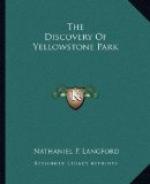Wednesday, September 7.—Last night when all but the guards were asleep, we were startled by a mountain lion’s shrill scream, sounding so like the human voice that for a moment I was deceived by it into believing that some traveler in distress was hailing our camp. The stream near the bank of which our camp lay, flows into the southeast arm of Yellowstone lake, and for which the name “Upper Yellowstone” has been suggested by some of our party; but Lieutenant Doane says that he thinks he has seen on an old map the name “Bridger” given to some body of water near the Yellowstone. We tried to cross the river near its mouth, but found the mud in the bed of the stream and in the bottom lands adjoining too deep; our horses miring down to their bellies. In accordance with plans agreed upon last night, General Washburn and a few of the party started out this morning in advance of the others to search for a practicable crossing of the river and marshes, leaving the pack train in camp.
In company with Lieutenant Doane I went out upon a reconnaissance for the purpose of determining the elevation of the mountains opposite our camp, as well as the shape of the lake as far as we could see the shore, and also to determine as far as possible our locality and the best line of travel to follow in passing around the lake. There is just enough excitement attending these scouting expeditions to make them a real pleasure, overbalancing the labor attendant upon them. There is very little probability that any large band of Indians will be met with on this side of the lake, owing to the superstitions which originate in the volcanic forces here found.
We followed along the high bank adjacent to the bottom through which the river runs in a direction a little south of east for the distance of about three miles, when we entered a heavily timbered ravine, which we followed through the underbrush for some three miles, being frequently obliged to dismount and lead our horses over the projecting rocks, or plunging through bushes and fallen timber. At the end of two hours we reached a point in the ascent where we could no longer ride in safety, nor could our horses climb the mountain side with the weight of our bodies on their backs. Dismounting, we took the bridle reins in our hands, and for the space of an hour we led our horses up the steep mountain side, when we again mounted and slowly climbed on our way, occasionally stopping to give our horses a chance to breathe. Arriving at the limit of timber and of vegetation, we tied our horses, and then commenced the ascent of the steepest part of the mountain, over the broken granite, great care being necessary to avoid sliding down the mountain side with the loose granite. The ascent occupied us a little more than four hours, and all along the mountain side, even to near the summit, we saw the tracks of mountain sheep. The view from the summit of this mountain, for wild and rugged grandeur, is surpassed by none I ever before




